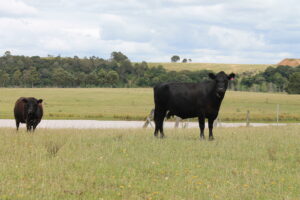US cattle prices have come off peaks a little in the last week, but they remain at extreme highs. Here we give an update on how far behind the US we are, and look for potential upside at saleyard levels.
The spreadsheet used for this analysis is called ‘Any support from record US prices’. It was created in 2014, which was the last time the US market was in the midst of a manic herd rebuild, following a drought-driven liquidation. At that time Australian cattle prices were in the doldrums thanks to oversupply and dry seasonal conditions. History it seems is repeating.
Figure 1 shows US Live Cattle and Feeder Cattle Futures. Both US cattle futures prices have been on an upward trend since mid-2022, but have recently had a check. Increasing feedlot inventories and negative processor margins have spooked the market a little.
Despite the recent falls, Live Cattle Futures sit 15% above this time last year, and Feeder Cattle Futures are at a 26% premium. Figure 1 shows that US cattle prices have only been higher for very short periods prior to this.
The Australian discount to US values was huge in 2014, but it’s even bigger now. Figure 1 shows US Feeder Cattle Futures and the Eastern Young Cattle Indicator (EYCI) in our terms. With US Feeders at 1450¢/kg cwt, or 780¢/kg lwt, US Feeders are priced at three times the price of equivalent cattle here.
For finished cattle the story is similar. US Live Cattle prices in our terms have surpassed the highs seen here back in 2022 and set a new benchmark of $10/kg cwt. That’s $3,500 per head for a 350kg cwt finished steer.
Figure 2 shows the NSW Heavy Steer saleyard indicator, which might be a little cheaper than the grain-fed equivalent, sitting at 370¢/kg cwt. The US price is more than 2.5 times more than the Australian price.
Australian beef exports are running hot, and little wonder. Our beef is very cheap relative to US prices, and it should be finding plenty of demand at current values.
What does it mean?
We’ve been talking about processing bottlenecks for a while, and we’ve got another example here. There are more cattle for sale than processors can handle, as this forces prices down to a level where producers are more likely to hold.
Unfortunately by the time supply issues turn around, the US market will have come off its peaks. Despite this, the upside remains huge for both finished and young cattle, once the current supply glut is worked through.
Have any questions or comments?
Key Points
- US cattle futures have come off peaks, but remain at extremely high levels.
- Australian cattle values are highly discounted to the US due to heavy supply.
- There is significant upside for cattle prices when supplies ease.
Click on figure to expand
Click on figure to expand
Click on figure to expand
Data sources: CME,MLA, Mecardo















